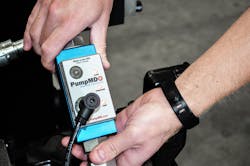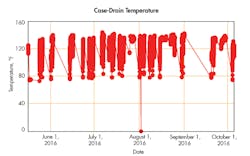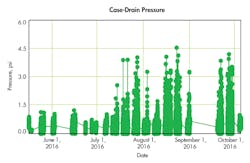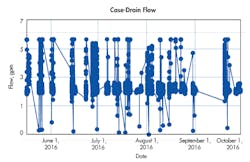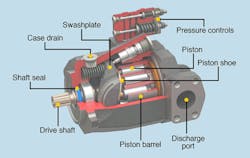This file type includes high-resolution graphics and schematics when applicable.
A hydraulic pump doesn’t fail only when it doesn’t put out the required flow. A pump actually fails once its efficiency falls below its manufacturer’s operating specifications, including overall efficiency.
Inefficiency can be caused by reasons too numerous to mention here. Therefore, this discussion will be limited to axial-piston pumps that were properly installed but, for one reason or another, begin to lose efficiency over time. The most common causes for loss in efficiency are fluid contamination, poor maintenance, and using the wrong hydraulic fluid for the operating conditions.
Anatomy of Pump Failure
Axial-piston pumps contain multiple small passageways and sliding surfaces separated by tight tolerances. These can be the source of failures if the pump operates under less than optimal conditions. For example, each piston has an orifice drilled from front to back and through its piston shoe, which is attached to the rear of each piston through a ball joint. Each piston shoe contains grooves to provide hydrostatic balance to offset the load from fluid pressure. The barrel, which contains the pistons, is spring-loaded against the swashplate to keep the piston shoes in contact with the swashplate.
Designed-in leakage provides lubrication between and through all of these parts. The amount of leakage depends on the pump’s displacement, speed, fluid flow and pressure, and temperature. Internal leakage (volumetric inefficiency) specifications are readily available from the pump’s manufacturer. Manufacturers also publish maximum recommended case pressure and fluid temperature.After placing the pump into service, the piston shoes will wear over time. Wear occurs in proportion to the cleanliness of the oil being pumped—the dirtier the oil, the more rapid the wear. This wear increases oil flow to the pump case, pump-case temperatures, and case pressure from the backpressure that develops behind the case drain port. The increased pump-case pressure can affect the hydrostatic balance of the pistons, causing leakage through the pump-shaft seal.
When one or more internal components of a pump fails, metallic debris becomes scattered throughout the pump cavity and eventually works its way out into the rest of the hydraulic system, putting all other components at risk of premature failure. The result is usually much more than the expense of repairing the pump.
Because the debris will likely circulate through the entire hydraulic system, extensive assessments should be performed to ensure other areas have not become vulnerable. As wear degrades a pump’s critical tolerances, excess fluid leaks past internal seals and moving parts into the case, robbing the pump of efficiency. Moreover, the associated downtime often results in thousands of dollars in lost production.
Pump Diagnosis Through the Case Drain
When taking all of this into account, it becomes evident that the case drain can be a key indicator of a pump’s health by monitoring flow, temperature, and pressure. Furthermore, this all can be done while the pump is running. Case-drain flow exceeding a percentage of total pump output signals the need for maintenance or complete pump rebuild.
Many manufacturers offer axial-piston hydraulic pumps with similar power, pressure, and flow ratings. But rarely do any two pumps share the same dimensional and performance characteristics. This makes it difficult to establish baseline performance criteria for any given pump model.
However, a new diagnostic device, PumpMD, lets users configure the device to the specific model and size of hydraulic axial-piston pump. A web-based configurator matches the PumpMD to a specific pump. Users enter information such as case-drain port size, maximum case-drain pressure, continuous input shaft speed, and maximum displacement.
The Wi-Fi-enabled PumpMD collects this information and continuously monitors the three critical operating parameters, which can be analyzed through a mobile app. Users are able to view current and historical data of one or more hydraulic pumps to assess efficiency and operating trends. Threshold levels can also be established at setup to send an alarm to the user’s smartphone when any parameter reaches established level.
The PumpMD also provides local monitoring of case drain flow, pressure, and temperature. LEDs glow green when parameters fall within prescribed levels for a specific pump. If any parameter exceeds its preset threshold, any one of the LEDs will glow red.
Matt Belisle is a design engineer at PumpMD, Cincinnati. For more information, call PumpMD at (844) 786-7631, or visit www.mypumpmd.com.


